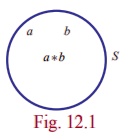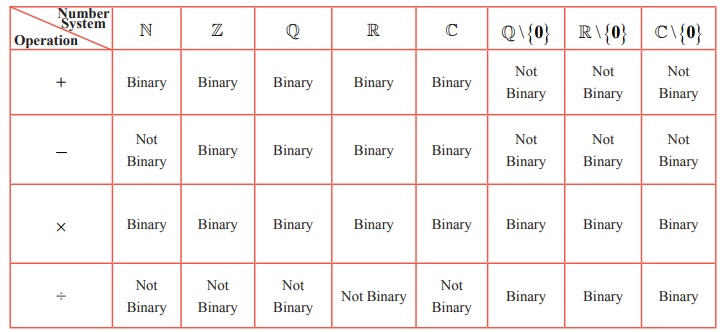Discrete Mathematics | Mathematics - Definitions of Binary Operations | 12th Maths : UNIT 12 : Discrete Mathematics
Chapter: 12th Maths : UNIT 12 : Discrete Mathematics
Definitions of Binary Operations
Binary
Operations
Definitions
The basic arithmetic operations ℝ on are addition (+), subtraction (−), multiplication (×), and division (÷). Eminent mathematicians
of the latter part of 19th century and in 20th century
like Abel, Cayley, Cauchy, and others,
tried to generalize the properties satisfied by these usual arithmetic
operations. To this end they developed new abstract algebraic structures
through the axiomatic approach.
This new branch of algebra dealing with these abstract algebraic structures is
known as abstract
algebra.
To begin with, consider a simple example involving the basic
usual arithmetic operations addition and multiplication of any two natural
numbers.
m + n ∈ ℕ ; m ×
n ∈ ℕ, ∀m, n ∈ ℕ = {1, 2, 3,...}
Each of the above two operations yields the following
observations:
(1) At a
time exactly two elements of ℕ are
processed.
(2) The
resulting element (outcome) is also an element of ℕ.
Any such operation defined on a nonempty set is called a binary
operation or a binary composition on the
set in abstract algebra.
Definition 12.1
Any operation * defined on a
non-empty set S is called a binary operation
on S if
the following conditions are satisfied:
(i) The operation * must be defined
for each and every ordered pair (a , b) ∈ S × S .
(ii) It assigns a unique element a∗b of S to every ordered
pair (a , b) ∈ S × S .
In other words, any binary operation * on S is a rule that assigns to each ordered
pair of elements of S a unique
element of S . Also * can
be regarded as a function (mapping) with input in the Cartesian product S × S
and the output in S .
∗
: S × S
→
S ; ∗( a , b) =
a ∗ b
∈ S
, where a *b is an unique element.
A binary operation defined by ∗ : S × S →
S ; ∗( a , b) =
a ∗ b
∈ S
demands that the output a ∗b must always lie the given set S and not in the complement of it. Then
we say that ‘ ∗ is
closed on S ’ or ‘ S is closed
with respect to ∗
’. This property is known as the closure property.
Definition 12.2
Any non-empty set on which one or more binary operations are
defined is called an algebraic structure.

Another way of defining a binary operation ∗
on S is as follows:
∀ a , b ∈ S , a∗b is unique and a ∗ b ∈ S .
Note
It
follows that every binary operation satisfies the closure property.
Note
The
operation ∗ is just
a symbol which may be + , ×, −, ÷ matrix addition, matrix multiplication,
etc. depending on the set on which it is defined.
For
instance, though + and × are binary on ℕ, − is not binary operation on ℕ.
To
verify this, consider (3, 4) ∈
ℕ ×
ℕ.
∗ ( a , b) = −
(3, 4) =
3 −
4 = −1
∉ ℕ.
Hence − is not binary operation on ℕ. So ℕ is to be extended to ℤ in order that − becomes binary operation on ℤ. Thus ℤ is closed with respect to +
, ×,
and −
. Thus (ℤ, + , ×, −) is an algebraic structure.
Observations
The
binary operation depends on the set on which it is defined.
(a) The
operation – which is not binary operation on ℕ but it is binary on ℤ. The set ℕ is extended to include negative
numbers. We call the included set ℤ.
(b) The
operation ÷ on ℤ is
not binary
operation on ℤ.
For instance, for (1, 2) ∈
ℤ ×
ℤ, ÷ (1, 2) = 1/2 ∉ ℤ. Hence ℤ has
to be extended further into ℚ.
(c) It
is a known fact that the division by 0 is not defined in basic arithmetic. So ÷ is
binary operation on the set ℚ\{0}.
Thus +
, ×,
−
are binary operation on ℚ and
÷ is binary operation ℚ on
\{0}.
Now the
question is regarding the reasons for extending further ℚ to and then from ℚ to C.
Accordingly, a number system is needed where not only all the basic arithmetic
operations +, −, ×, ÷ but also to include the roots of
the equations of the form “ x2 − 2 = 0 ”
and“ x2 + 1 = 0 ”.
So, in
addition to the existing systems, the collection of irrational numbers and
imaginary numbers (See Chapter 3) are to be adjoined. Consequently ℝ and then C are obtained. The biggest number system C properly includes all the other number systems ℕ, ℤ, ℚ,
and ℝ as subsets.

Table12.1
Example12.1
Examine
the binary operation (closure property) of the following operations on the
respective sets (if it is not, make it binary):
(i) a ∗ b = a + 3ab − 5b2 ; ∀ a,b
∈ ℤ

Solution
(i) Since
×
is binary operation on ℤ, a ,
b ∈ ℤ ⇒ a × b = ab ∈ ℤ and b × b = b2 ∈ ℤ ... (1)
The fact
that + is binary operation on ℤ and
(1) ⇒ 3ab = ( ab + ab + ab) ∈ ℤ and
5b2 = (b2 +
b2 + b2 + b2 +
b2) ∈ ℤ. .... (2)
Also a ∈ ℤ and 3ab ∈
ℤ implies a + 3ab ∈ ℤ. ... (3)
(2), (3),
the closure property of − on ℤ yield
a ∗ b = ( a + 3ab − 5b2 ) ∈ ℤ. Since a ∗ b belongs to ℤ, *
is a binary operation on ℤ.
(ii) In
this problem a ∗b is in the quotient form. Since the division
by 0 is undefined, the denominator b -1must
be nonzero.
It is
clear that b −
1 =
0 if b = 1. As 1∈ ℚ, ∗
is not a binary operation on the whole of ℚ.
However
it can be found that by omitting 1 from ℚ, the output a ∗b exists in ℚ\{1} .
Hence ∗ is a binary operation on \{1} .
Related Topics